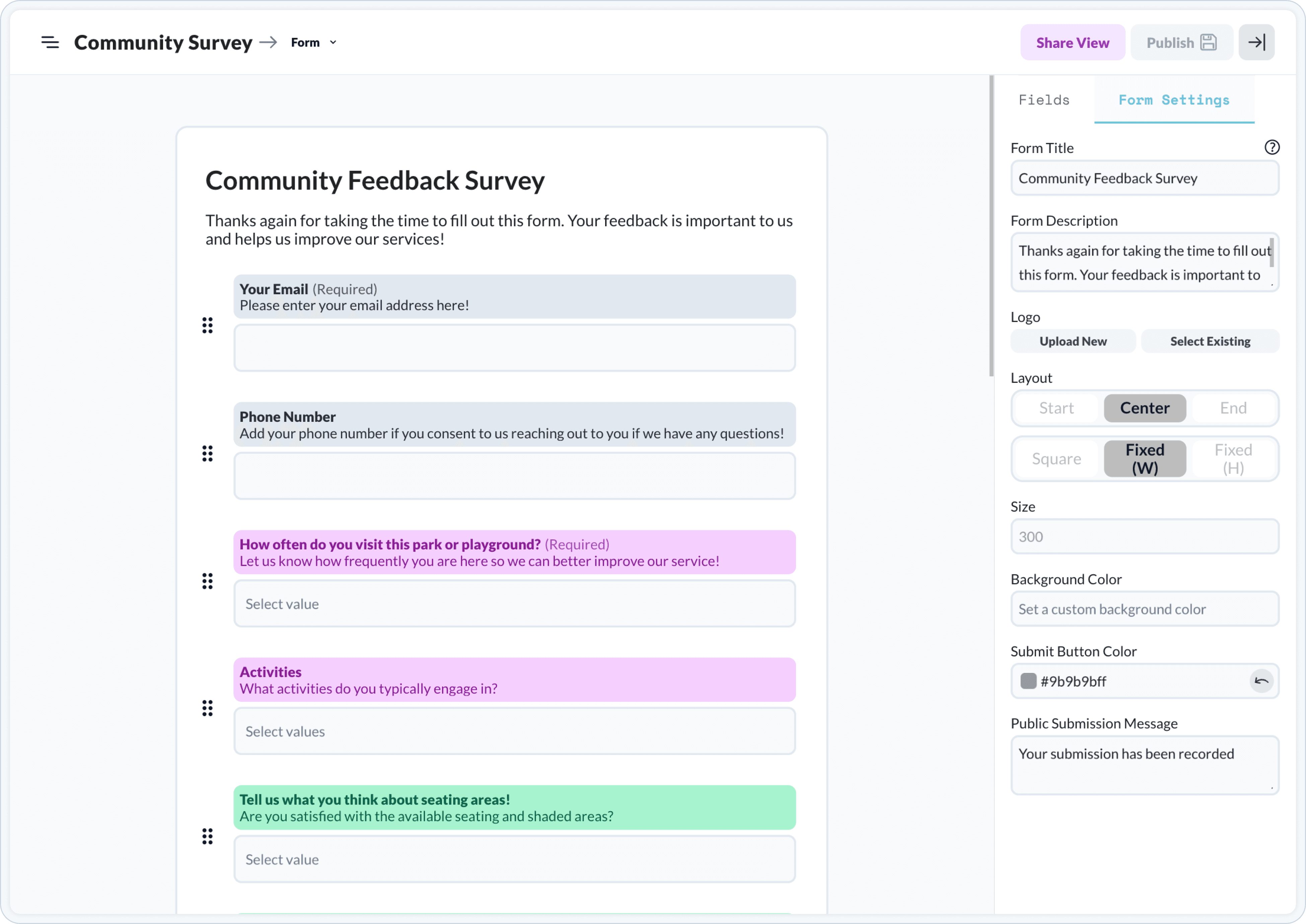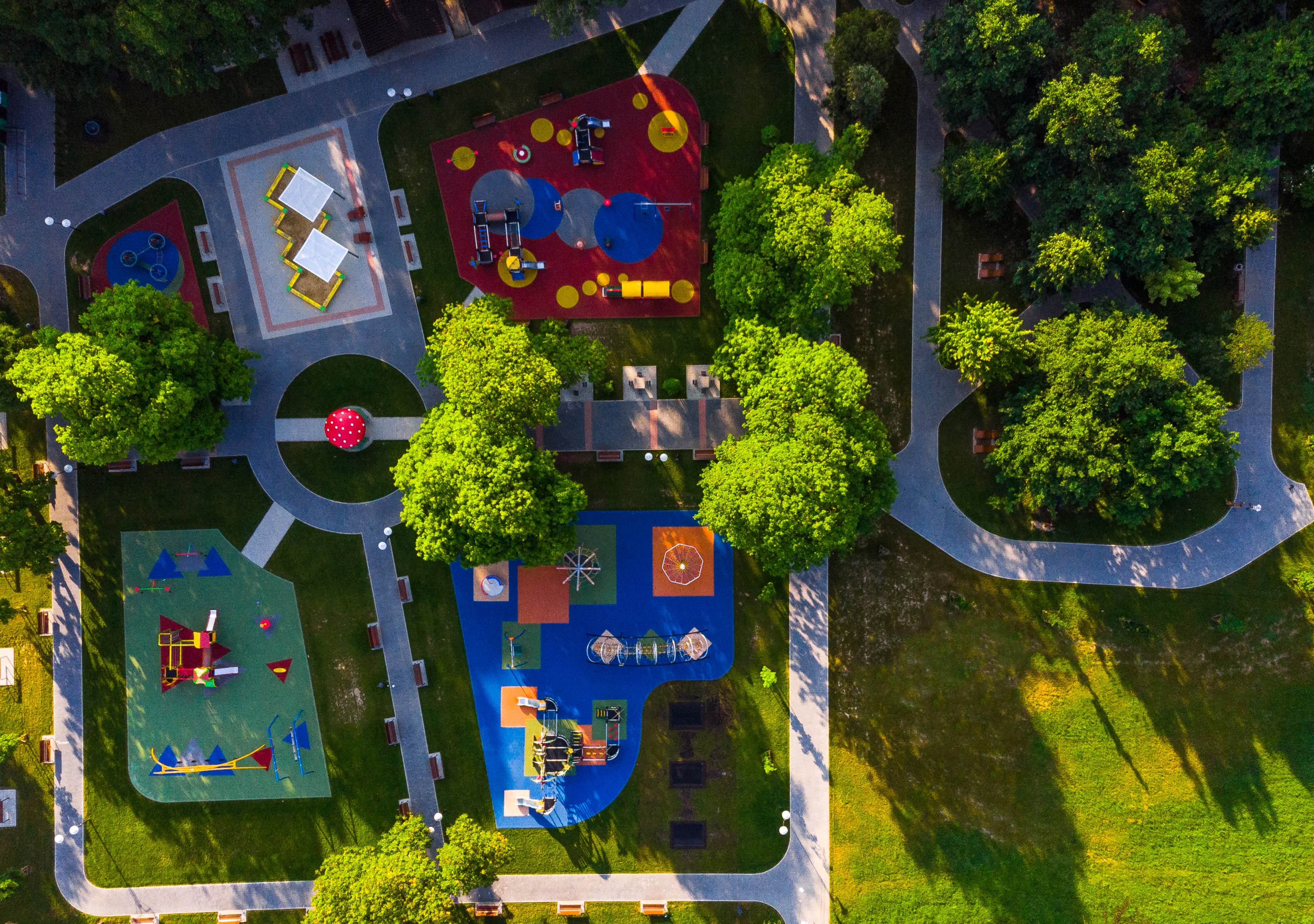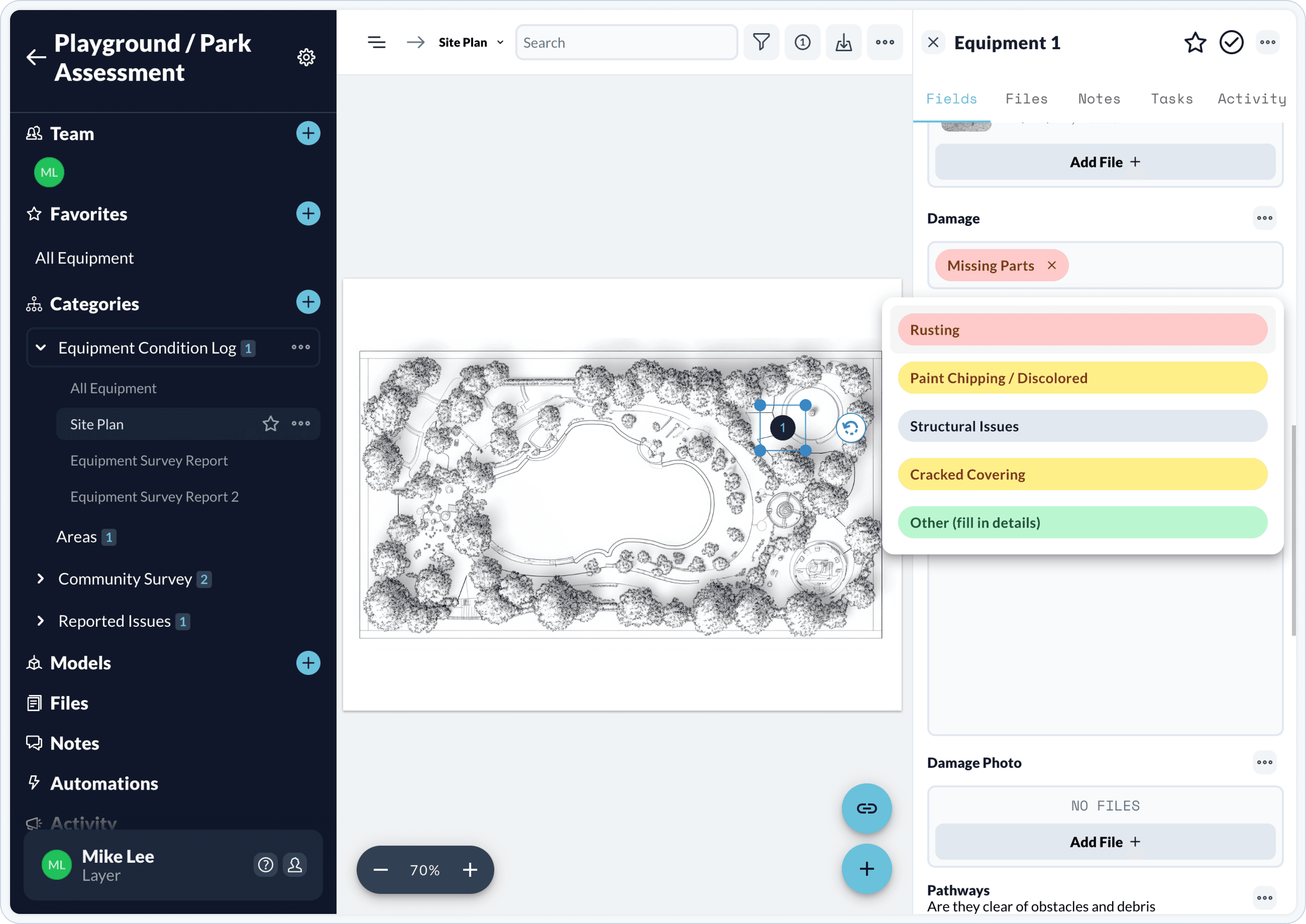Layer Workflow Guides
Layer Workflow Guides
Layer Workflow Guides
The Ultimate Guide to Park and Playground Surveys
The Ultimate Guide to Park and Playground Surveys
The Ultimate Guide to Park and Playground Surveys
Park and playground surveys combine community feedback with assessments of the built environment to create a detailed understanding of what’s working, what isn’t, and where improvements can be made.

Mike Lee

Mike Lee

Mike Lee
Updated: Nov 19, 2025



This guide explores how to design effective surveys, gather meaningful feedback, and assess the physical conditions of parks and playgrounds. By addressing both aspects, you can develop actionable plans that enhance these vital spaces for everyone.
Why Conduct Park and Playground Surveys?
Before you ever break ground, you have to understand what you are working with & plan. Surveys provide a structured way to evaluate user experiences and the condition of public spaces.
Depending on your project requirements you should consider the driver your client has for improving an existing green space or creating a new one. Here are some common reasons your client may have:
Gather Community Insights: Understand the preferences, challenges, and needs of users across age groups and abilities.
Evaluate Accessibility: Ensure their facilities, parks, or playgrounds are inclusive and easy to navigate for all users, including those with disabilities.
Enhance Safety: Identify hazards in play areas, walking paths, or other facilities.
Promote Community Ownership: Engage the public in decision-making to foster pride and participation.
Prioritize Maintenance: Highlight areas requiring immediate attention and plan for long-term upkeep.
Part 1: Gathering Community Feedback

If your survey involves gathering community feedback you should consider these 3 key items:
Make the survey accessible to respondents to get the best dataThis one sounds simple, but is often overlooked. If the facility is an existing one, it may be helpful to have posters printed for the owner with a QR code linking to a public survey form.
Send the right remindersIf you have an audience that you are requesting feedback from, you should design the request cadence to give respondents proper notice, but not be annoying. A detailed email when the survey opens requesting feedback and explaining why it’s important, plus a reminder at the halfway point and 1-2 days before responses close is appropriate.
Design the survey to capture the data you need to design
Key Topics to address in your survey
When designing a park and playground survey, focus on topics that capture the user experience:
Overall Satisfaction: Ask about user contentment with the park or playground.
Facilities and Amenities: Request respondents assess the quality of features like benches, restrooms, landscape features, and picnic areas.
Recreational Equipment: Add questions about the usability and appeal of play structures, fitness equipment, and sports facilities as necessary.
Safety: Ask about crime, lighting, or hazardous conditions such as broken or damaged equipment.
Accessibility: Do paths, parking, and facilities accommodate users with diverse needs?
Cleanliness and Maintenance: Seek to understand how users perceive the upkeep of the area.
Here are 6 basic questions applicable to most facilities that can get you started:
How often do you visit this park or playground?
What activities do you typically engage in when visiting?
Are you satisfied with the available
Do you feel safe using this park or playground during the day and at night?
Are there barriers that make it difficult for you to access this space?
What additional features or improvements would you like to see?
Remember to consider your audience when designing your questions. Use appropriate terminology and add visual aids as needed.
Here are some best practice tips for collecting representative feedback:
Give options where possible instead of freetext
Respect privacy, but request demographic information
Use the right delivery format & give appropriate language options
Ask the right questions for your audience! For example:
Parents & Caregivers: Your questions may wish to focus heavily on safety, inclusivity, and facilities such as restrooms & diaper changing facilities.
Seniors: Focus on accessibility, quiet spaces, and walking paths.
Educators and Community Leaders: It might make sense to ask if they envision opportunities for educational programming and community events and what type of spaces they would need.
Part 2: Assessing the Built Environment
In tandem with collecting public feedback, you’ll be asked to evaluate the facility and report on your findings. In comparison with the request for public feedback you will be required to provide an objective report that is both qualitative and at least partially quantitative.

What does that mean to a layman? An architect or engineer will go on site to physically survey, verify, measure, and record the condition of the existing built environment.
What is the Built Environment?
The built environment refers to the human-made elements that shape the park, facility, or playground. This includes any paved structures, lighting, water features, equipment, seating, and any buildings.
Every project is different. Based on the proposed scope of work you may wish to design your survey considering the following aspects:
Accessibility:
Playground or Exercise Equipment:
Safety:
Infrastructure:
Aesthetics:
What kind of structured questions or other data should be collected?

Use pre-defined ratings & scores:
Photography:
Part 3: Integrating Community Feedback and Built Environment Assessments
Once the on-site survey is complete and your community feedback window has closed, it’s time to assess the data and make recommendations.
As a deliverable, you’ll typically be asked to provide feedback in several ways. The first is in delivering the dataset as a formatted set of survey and submission reports. These are typically delivered as a spreadsheet or PDF.
Pro-Tip: If you captured your data in a single workflow platform like Layer, you can just export your pre-formatted survey reports to save time during this process.
Next, you’ll be asked to provide analysis of the findings. Here are some suggestions on how you can do that:
Tag findings to locations so that you can overlay them and understand what areas have the most documented findings.
Identify overlapping concerns by grouping similar tags. For example damaged equipment, broken restroom facilities, or insufficient shade.
Highlight opportunities for improvement based on both user needs and physical conditions.
Next, make suggestions for the owner
Short-Term Goals: What immediate issues are there such as safety hazards that should be addressed today?
Long-Term Goals: How do survey responses and your site analysis stack up with the goals the owner had before going into this process? Keep in mind timeline requirements and availability of equipment if suggesting replacements.
Resource Allocation: Where should the owner best allocate resources? Leverage the pareto principle here. Your analysis above should identify key areas where you can make the most improvements to the most people. Start with those areas first and work your way down the list.
Then, provide engagement and information to the community, or share it with the owner for them to do so. Your tallied surveyed results with any personally identifiable information removed may be of interest to the community. If the owner wishes you can give them your summary reports with redacted information to share.
Conclusion
Park and playground surveys are essential for creating safe, inclusive, and enjoyable spaces. By combining community feedback with detailed assessments of the built environment, you can make informed decisions that benefit all users.
Recording, blending, and reporting on this data can be tedious and time consuming. Streamlining this process in a single tool can save you time and effort that is better spent on interpreting the results and providing your insights to your client.
Ready to eliminate the busy work? Layer’s new Parks & Playground Survey is coming February 03, 2025!
This guide explores how to design effective surveys, gather meaningful feedback, and assess the physical conditions of parks and playgrounds. By addressing both aspects, you can develop actionable plans that enhance these vital spaces for everyone.
Why Conduct Park and Playground Surveys?
Before you ever break ground, you have to understand what you are working with & plan. Surveys provide a structured way to evaluate user experiences and the condition of public spaces.
Depending on your project requirements you should consider the driver your client has for improving an existing green space or creating a new one. Here are some common reasons your client may have:
Gather Community Insights: Understand the preferences, challenges, and needs of users across age groups and abilities.
Evaluate Accessibility: Ensure their facilities, parks, or playgrounds are inclusive and easy to navigate for all users, including those with disabilities.
Enhance Safety: Identify hazards in play areas, walking paths, or other facilities.
Promote Community Ownership: Engage the public in decision-making to foster pride and participation.
Prioritize Maintenance: Highlight areas requiring immediate attention and plan for long-term upkeep.
Part 1: Gathering Community Feedback

If your survey involves gathering community feedback you should consider these 3 key items:
Make the survey accessible to respondents to get the best dataThis one sounds simple, but is often overlooked. If the facility is an existing one, it may be helpful to have posters printed for the owner with a QR code linking to a public survey form.
Send the right remindersIf you have an audience that you are requesting feedback from, you should design the request cadence to give respondents proper notice, but not be annoying. A detailed email when the survey opens requesting feedback and explaining why it’s important, plus a reminder at the halfway point and 1-2 days before responses close is appropriate.
Design the survey to capture the data you need to design
Key Topics to address in your survey
When designing a park and playground survey, focus on topics that capture the user experience:
Overall Satisfaction: Ask about user contentment with the park or playground.
Facilities and Amenities: Request respondents assess the quality of features like benches, restrooms, landscape features, and picnic areas.
Recreational Equipment: Add questions about the usability and appeal of play structures, fitness equipment, and sports facilities as necessary.
Safety: Ask about crime, lighting, or hazardous conditions such as broken or damaged equipment.
Accessibility: Do paths, parking, and facilities accommodate users with diverse needs?
Cleanliness and Maintenance: Seek to understand how users perceive the upkeep of the area.
Here are 6 basic questions applicable to most facilities that can get you started:
How often do you visit this park or playground?
What activities do you typically engage in when visiting?
Are you satisfied with the available
Do you feel safe using this park or playground during the day and at night?
Are there barriers that make it difficult for you to access this space?
What additional features or improvements would you like to see?
Remember to consider your audience when designing your questions. Use appropriate terminology and add visual aids as needed.
Here are some best practice tips for collecting representative feedback:
Give options where possible instead of freetext
Respect privacy, but request demographic information
Use the right delivery format & give appropriate language options
Ask the right questions for your audience! For example:
Parents & Caregivers: Your questions may wish to focus heavily on safety, inclusivity, and facilities such as restrooms & diaper changing facilities.
Seniors: Focus on accessibility, quiet spaces, and walking paths.
Educators and Community Leaders: It might make sense to ask if they envision opportunities for educational programming and community events and what type of spaces they would need.
Part 2: Assessing the Built Environment
In tandem with collecting public feedback, you’ll be asked to evaluate the facility and report on your findings. In comparison with the request for public feedback you will be required to provide an objective report that is both qualitative and at least partially quantitative.

What does that mean to a layman? An architect or engineer will go on site to physically survey, verify, measure, and record the condition of the existing built environment.
What is the Built Environment?
The built environment refers to the human-made elements that shape the park, facility, or playground. This includes any paved structures, lighting, water features, equipment, seating, and any buildings.
Every project is different. Based on the proposed scope of work you may wish to design your survey considering the following aspects:
Accessibility:
Playground or Exercise Equipment:
Safety:
Infrastructure:
Aesthetics:
What kind of structured questions or other data should be collected?

Use pre-defined ratings & scores:
Photography:
Part 3: Integrating Community Feedback and Built Environment Assessments
Once the on-site survey is complete and your community feedback window has closed, it’s time to assess the data and make recommendations.
As a deliverable, you’ll typically be asked to provide feedback in several ways. The first is in delivering the dataset as a formatted set of survey and submission reports. These are typically delivered as a spreadsheet or PDF.
Pro-Tip: If you captured your data in a single workflow platform like Layer, you can just export your pre-formatted survey reports to save time during this process.
Next, you’ll be asked to provide analysis of the findings. Here are some suggestions on how you can do that:
Tag findings to locations so that you can overlay them and understand what areas have the most documented findings.
Identify overlapping concerns by grouping similar tags. For example damaged equipment, broken restroom facilities, or insufficient shade.
Highlight opportunities for improvement based on both user needs and physical conditions.
Next, make suggestions for the owner
Short-Term Goals: What immediate issues are there such as safety hazards that should be addressed today?
Long-Term Goals: How do survey responses and your site analysis stack up with the goals the owner had before going into this process? Keep in mind timeline requirements and availability of equipment if suggesting replacements.
Resource Allocation: Where should the owner best allocate resources? Leverage the pareto principle here. Your analysis above should identify key areas where you can make the most improvements to the most people. Start with those areas first and work your way down the list.
Then, provide engagement and information to the community, or share it with the owner for them to do so. Your tallied surveyed results with any personally identifiable information removed may be of interest to the community. If the owner wishes you can give them your summary reports with redacted information to share.
Conclusion
Park and playground surveys are essential for creating safe, inclusive, and enjoyable spaces. By combining community feedback with detailed assessments of the built environment, you can make informed decisions that benefit all users.
Recording, blending, and reporting on this data can be tedious and time consuming. Streamlining this process in a single tool can save you time and effort that is better spent on interpreting the results and providing your insights to your client.
Ready to eliminate the busy work? Layer’s new Parks & Playground Survey is coming February 03, 2025!
Contents
Published: Jan 20, 2025
Keep Reading
Keep Reading
Written by
Get Started Today
Want to see how Layer can transform the way your team works?
Get Started Today
Want to see how Layer can transform the way your team works?
Get Started Today
Want to see how Layer can transform the way your team works?
Solutions
Solutions
Solutions


